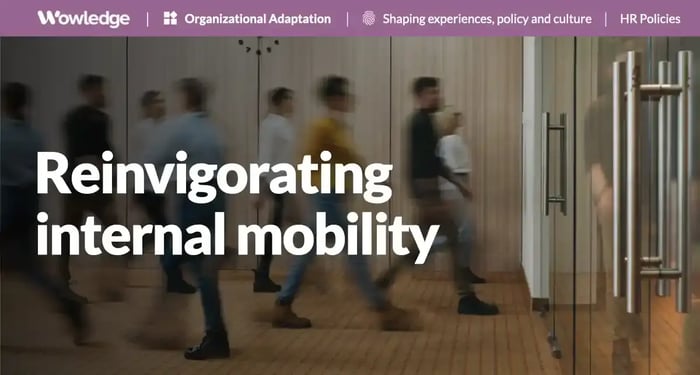Implementing a robust internal mobility program is a strategic move that can reshape the landscape of an organization, fostering a dynamic and engaged workforce. At its core, this program is designed to retain valuable talent and enhance overall productivity. By providing employees with opportunities to explore different roles within the company, the program encourages a sense of loyalty and commitment, creating a significant impact of internal mobility on talent outcomes. Simultaneously, the varied experiences gained through internal mobility contribute to skill building, creating a workforce that is adaptable, versatile, and well-equipped to handle diverse challenges.
Furthermore, the positive effects of a well-structured internal mobility program ripple through various facets of organizational excellence. It catalyzes innovation by promoting a culture of collaboration, diverse thinking, and cross-functional experiences. As employees move between departments and roles, they bring fresh perspectives, fostering an environment conducive to creativity and problem-solving. Additionally, the program lays the foundation for leadership development, preparing a cadre of future leaders skilled and well-versed in the intricacies of different aspects of the organization. This holistic approach to talent management ensures that employees remain engaged, productive, and continuously evolving, positioning the organization for sustained success in an ever-changing business landscape. The impact of internal mobility on talent outcomes can be substantial.
Organizational research provides substantial support for formalizing and institutionalizing mobility programs and practices. Compared to internal promotions/transfers, external hires are 61% more likely to be fired or laid off in the first year of employment and 21% more likely to voluntarily resign. External hires have also been found to take longer to achieve full competency in their role, taking three (3) years to perform at the same level as internal transfers or promotions into the same role.
Research has demonstrated the value of solid mobility practices and cultures. From a recruiting perspective, internal mobility is one of the most efficient candidate-sourcing channels. It has been shown to require only four (4) internal applicants to produce a successful hire, compared to 36 external candidates from job boards to result in that same hire.
Other research demonstrates that such practices are linked to high corporate performance. For example, research has found that high-performing companies were twice (2X) as likely to promote and value internal talent mobility versus the low-performers being 2.5 times more likely to report that such movement does not deserve such prioritization. In fact, 74% of those lower-performing companies report that talent-hoarding by managers is a critical issue they face.
Furthermore, SHRM reported that first-year turnover is shown to be 24% and increase to 62% by year five. However, employees promoted in their first three years were 70 percent more likely to continue their employment, and those who made a lateral move were 62 percent more likely to be retained. This is exceptional compared to those who made no job change in the first three years and had only a 45 percent chance of remaining with the organization. The differences are stark (and expensive).
The greatest issue facing companies is the growth in skills gaps, with some surprising functional gaps noted in McKinsey's research. For example, the top three functions that are experiencing the most significant gaps in skills availability track with the most valued in many corporations today (data analytics, IT/mobile/web design & management), with the third representing the biggest threat to strategic success (executive management). Other critical functions where the percentage of companies reporting gaps included sales and marketing operations, product or service design, research and development, frontline management, customer service, and other essential business capabilities.

The value and linkage of mobility programs to talent outcomes
Talent mobility programs and practices emerge as powerful drivers of enhanced talent outcomes within organizations. These strategic initiatives focus on the dynamic movement of employees across various roles and functions, unlocking many benefits. By facilitating the smooth flow of talent within the company, these programs bolster employee engagement and job satisfaction and play a pivotal role in skill development. As individuals navigate different positions and departments, they acquire a versatile skill set that aligns with the organization's evolving needs. This enriches individual career paths and ensures that the collective talent pool is well-prepared and adaptable in the face of changing industry landscapes. In essence, talent mobility programs emerge as a cornerstone for optimizing talent potential, fostering continuous growth, and driving superior outcomes in the ever-evolving realm of workforce management. The impact of internal mobility on talent can be seen in a number of critical outcomes.
The potential to impact employee retention
Having established the linkage between mobility programs, processes, and practices to enhance employee retention, a well-designed ecosystem can drive longer and more productive employee tenures through many avenues and points of impact in the employee experience and the most desired outcomes.
1. Career development opportunities: Internal mobility allows employees to explore different organizational roles, providing career growth and development opportunities. Employees who see a clear path for advancement and continuous learning enjoy greater alignment with company culture, direction, and objectives.
2. Increased employee engagement: Knowing they can take on new organizational challenges and responsibilities can boost employee engagement. Engaged employees are more likely to be satisfied with their work, feel a sense of purpose, and are less likely to seek opportunities elsewhere.
3. Improved employee morale: Employees appreciate being recognized and valued. When an organization actively promotes internal mobility, it sends a positive message to the workforce that it cares and wants them to grow with it. The perception that the company is invested in the growth and success of its employees can contribute to higher allegiance to its employer brand.
4. Strengthened employee loyalty: Offering internal mobility opportunities signals to employees that the organization is invested in their long-term success. This investment fosters a sense of loyalty, as employees recognize the company's commitment to supporting their career development.
5. Retention of institutional knowledge: Employees who have been with the organization for a significant tenure tend to possess valuable institutional knowledge. Internal mobility allows the company to retain this knowledge, preventing a loss of critical information and expertise when employees decide to leave.
The potential to impact employee productivity
A robust internal mobility and transfer culture and capability can improve employee productivity positively. Employee competencies can be systematically grown by using mobility to support the continuous development of employee skills to benefit current and future roles. How such programs, policies, processes, and practices support the ongoing optimization of productivity include:
1. Skill enhancement: Internal mobility allows employees to acquire new skills and experiences by taking on different roles or responsibilities. This continuous learning and skill enhancement can make employees more versatile and better equipped to handle various tasks as they are applied across business situations and circumstances, ultimately increasing their productivity.
2. Increased motivation: Knowing the organization's opportunities for advancement and growth can motivate employees to perform at their best. The prospect of moving into more challenging or rewarding roles can drive individuals to excel in their current positions, expending their discretionary effort and positively impacting overall productivity.
3. Better job fit: A robust internal mobility program can support employees being matched with roles that align with their skills, interests, and strengths. Particularly when leveraging skills-based assessment, selection, and development practices, the result is an increased likelihood of having individuals in roles that fit their abilities, leading to higher engagement and productivity.
4. Faster onboarding: Internal moves often require less time for onboarding compared to bringing in external candidates. Employees are already familiar with the organization's culture, processes, and systems, which can lead to a quicker transition into the new role and, consequently, faster speed-to-productivity.
5. Enhanced collaboration and communication: Employees with experience in different departments or teams are better positioned to understand the perspectives and needs of various stakeholders within the organization. This cross-functional knowledge can improve collaboration and communication, leading to more efficient workflows and increased productivity.
The potential to impact employee innovation
The movement of employees, either laterally or vertically, between departments, functions, geographies, and business units can positively impact employee innovation within an organization. The transfer of problem-solving techniques, work methods, and ideation approaches boosts an organization where such cross-fertilization offers the ability to develop a more robust and resilient crop of business processes, practices, and outcomes. Often overlooked as a strategic imperative beyond the C-Suite walls, organizational units at all levels can leverage this to improve and enhance their operations continuously.
1. Diverse perspectives and ideas: Internal mobility allows employees to gain experience in different roles and departments. As individuals move across functions, they bring diverse perspectives, ideas, and approaches to problem-solving. This diversity of thought can stimulate innovation by introducing fresh viewpoints and insights.
2. Cross-pollination of skills: Employees with experience in multiple organization areas develop a broader skill set. When added to exposure to new or more advanced skills from their new managers and peers, it enables them to apply knowledge from one area to solve problems in another, fostering innovation by creatively applying diverse skills to new problem sets.
3. Collaboration and networking: Internal mobility encourages employees to build networks across various departments. This increased collaboration and networking facilitate the exchange of ideas and information, creating an environment that supports innovation. As employees establish new connections and expand their internal networks, they are more likely to collaborate on innovative projects with established relationships across the organization.
4. Adaptability to change: Employees who have experienced internal mobility are often more adaptable to change. This adaptability is crucial for innovation, allowing individuals to embrace new ideas, technologies, and processes. Teams composed of adaptable individuals are better positioned to innovate in response to changing market dynamics.
5. Fostering a learning culture: Internal mobility supports a learning culture within the organization. Employees have opportunities to take on new challenges and contribute to innovative projects and are thus encouraged to acquire diverse skills and embrace continuous learning. A culture that values learning is conducive to innovation, as employees are more open to experimenting with new ideas and approaches.
6. Breakdown of silos: Traditional organizational structures can create silos where departments operate independently. Internal mobility breaks down these silos by encouraging employees to move across functional boundaries. This facilitates the flow of information and ideas, preventing the isolation of knowledge that can hinder innovation.
7. Innovation from within: Employees who deeply understand the organization's operations and challenges are well-positioned to identify opportunities for innovation. Internal mobility allows these individuals to contribute ideas and solutions based on insider knowledge, driving innovation from within the organization.
The potential to impact employee skill development
By encouraging and enabling employee mobility at scale, continuous skill development becomes a core element of both the employee experience and the growth of the skills essential to meeting strategic corporate objectives. Particularly in a world where employees and managers are challenged to provide time for learning and upskilling while meeting current workload requirements, on-the-job or embedded development is an essential element of managing growth while maintaining productivity requirements. The use of mobility processes and practices can serve as a critical element of successful up- or re-skilling initiatives.
1. Diverse skill acquisition: Internal mobility encourages employees to take on different organizational roles. Exposure to various functions allows individuals to acquire a diverse set of technical and soft skills. This breadth of experience contributes to a well-rounded skill set, especially when the technical and soft skills needed to meet future demands are articulated and codified.
2. Cross-functional training: Moving between departments often involves learning new processes, technologies, and methodologies. This cross-functional training expands an employee's skill set and enhances their understanding of the broader organization. It enables employees to see how different parts of the business operate, integrate, and influence others’ decision-making and processes.
3. Adaptability and flexibility: Internal mobility necessitates adapting to new responsibilities and environments. This adaptability is itself a valuable skill. Employees learn to be flexible, open-minded, and quick to learn new skills, essential attributes in a rapidly changing business landscape.
4. Problem-solving abilities: Working in different roles often involves facing new challenges and problem-solving. Employees develop critical thinking skills as they tackle various issues across different functions. This problem-solving ability is transferable and applicable to many aspects of their work.
5. Enhanced communication skills: Internal mobility often requires effective communication, especially when transitioning between teams or departments. Employees can develop more comprehensive communication skills to convey their ideas as they collaborate with different stakeholders and operational environments.
6. Project management expertise: As project roles themselves can be a form of mobility, employees may manage projects from initiation to completion in roles with diverse responsibilities. This exposure enhances their project management skills, including planning, execution, coordination, progress tracking, and measurement, which are valuable in various professional contexts.
7. Customer focus: Moving through different roles allows employees to see the organization from different perspectives, including the customer's viewpoint. This understanding enhances their ability to empathize with customers and develop solutions that better meet their needs at different contact points with end-users.
8. Continuous learning mindset: Internal mobility fosters a culture of continuous learning. Employees become accustomed to the idea that their career paths may involve learning new skills and adapting to changing circumstances. This mindset encourages a commitment to ongoing personal and professional development.
The potential to impact employee leadership development and succession planning
The movement between roles, whether vertically (promotional) or laterally, can drive the acquisition and honing of leadership capabilities at an individual level, but when considered at an organizational level, it can also contribute to building a more ready-now cadre of future leaders. Transfers, promotions, and cross-functional project participation as a program are best deployed as a strategic process focused on developing specific skills and capabilities linked to each individual’s career potential and interests.
1. Exposure to diverse leadership styles: Internal mobility allows employees to work in different departments and under various leaders in different business environments. This exposure provides firsthand experience with different leadership styles, allowing individuals to learn and adapt diverse approaches to molding their personal leadership style.
2. Development of soft skills: Moving across roles and teams often requires effective communication, collaboration, and interpersonal skills. These soft skills are crucial for effective leadership. Employees who experience internal mobility have the opportunity to develop and refine these skills, potentially making them better-prepared leaders.
3. Cross-functional knowledge: Leaders who have experienced internal mobility better understand the organization's various functions. This cross-functional knowledge is valuable for leaders as it enables them to make informed decisions considering the broader impact on the organization and its operations. Decision-making capabilities can be significantly strengthened.
4. Adaptability and change management skills: Internal mobility involves adapting to new roles, teams, and responsibilities. Leaders who have navigated these changes are better equipped to handle organizational transitions and change management. This adaptability is crucial for leading in dynamic and evolving business environments.
5. Building a leadership pipeline: An internal mobility program identifies and nurtures potential leaders within the organization. Employees' leadership potential and capabilities become apparent as they move into different roles, driving future advancement and development decisions. This helps build a leadership pipeline, ensuring the development and opportunities to assess a pool of qualified candidates for leadership positions.
6. Succession planning: Internal mobility contributes to effective succession planning. Identifying, evaluating, and developing internal talent prepares individuals for critical contributor and leadership roles and reduces the need to recruit external candidates. Succession planning ensures a smooth transition of leadership and helps maintain organizational continuity.
7. Cultivating inclusive leadership: Exposure to diverse roles fosters a more inclusive leadership mindset. Leaders who have experienced internal mobility are more likely to understand and appreciate employees' contributions from different backgrounds and functions, leading to a more inclusive leadership culture.
8. Expedited onboarding for leadership roles: Internal mobility expedites the onboarding process for leadership roles. Leaders who have moved through different roles, functions, and businesses already deeply understand the organization's culture, processes, and challenges, enabling them to transition into leadership positions more smoothly and effectively.
9. Improved team dynamics: Leaders with experience in different roles are often better at understanding the needs and dynamics of diverse teams. This understanding can contribute to improved team collaboration, as leaders can tailor their leadership approach to the specific requirements of different functions.
Relevant Practices & Tools
Advanced Career Development Practices that Create a Culture of Mobility and Expand Employee Career Horizons with Technology. >
Advanced Career Development creates and manages a culture of career mobility by building a structured foundation for comparing jobs with overlapping capability requirements... more »
Aligning Career Development Strategies to Support Key Business Objectives. >
Evolving a career development program requires a direct linkage or flow-down from corporate strategic plans to the development program and processes... more »
Leveraging Tech-enabled DEI Solutions to Reduce Bias and Increase Screening Accuracy. >
Many of the complex diversity, equity, and inclusion challenges that organizations face are systemic. While every employee is responsible for making progress on organizational DEI goals... more »
Projecting Future Headcount Demand Requirements from Business Plans and External Estimates. >
An important step in Core workforce planning is to generate a sense of what will be faced in the future when working to maintain the proper level of a workforce that is suited... more »
The Individual Development Plan (IDP) Tool: Capture Targeted Employee Learning and Development Actions for a Performance Period. >
A plan of action to guide the employee throughout the coming performance period (e.g., year) as they continue to develop necessary knowledge, skills, abilities, and competencies... more »
About Wowledge
Wowledge is the expert-driven platform for lean teams building strategic HR programs. Members enjoy access to up-to-date best practices, step-by-step guides, tools, templates, and insights to accelerate the design and implementation of all key HR programs and processes.
Since each organization has unique characteristics, needs, and aspirations, Wowledge's practices are developed utilizing an exclusive stage-based approach – from Core to Advanced to Emerging – that reflects distinct levels of sophistication to meet our members where they are.
Build strategic HR programs with refreshingly easy-to-follow best practices.
Get started for FREE! Learn more.










